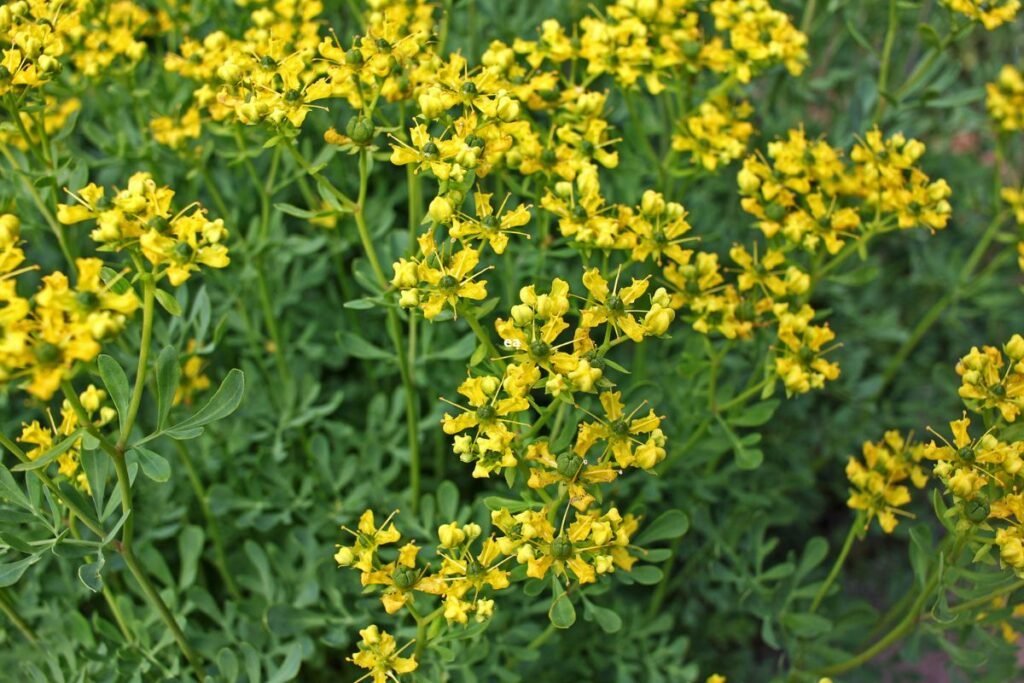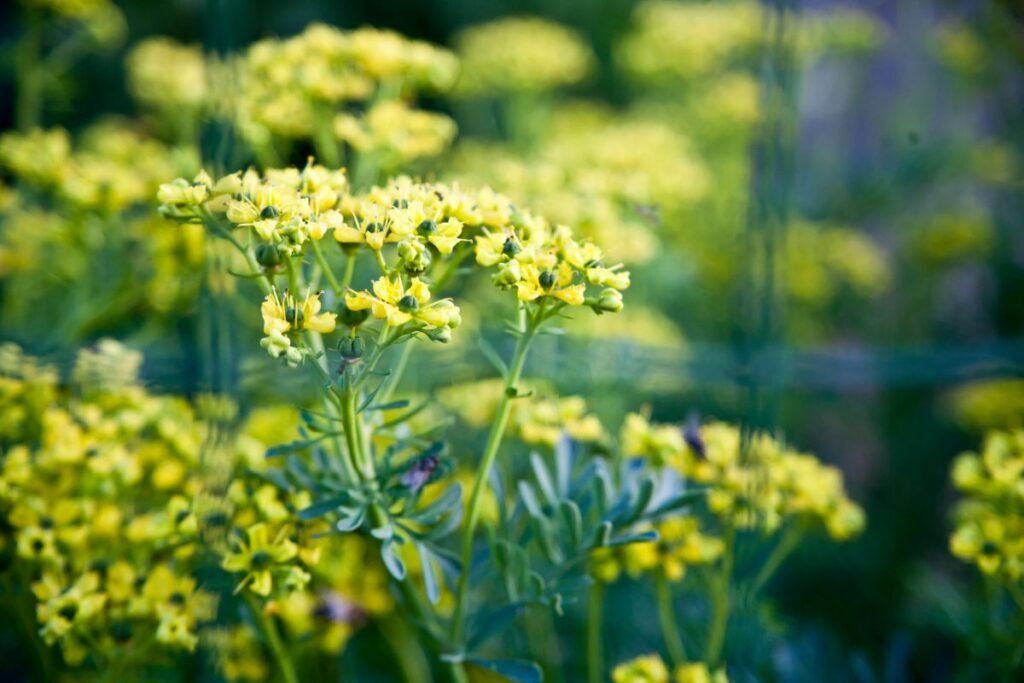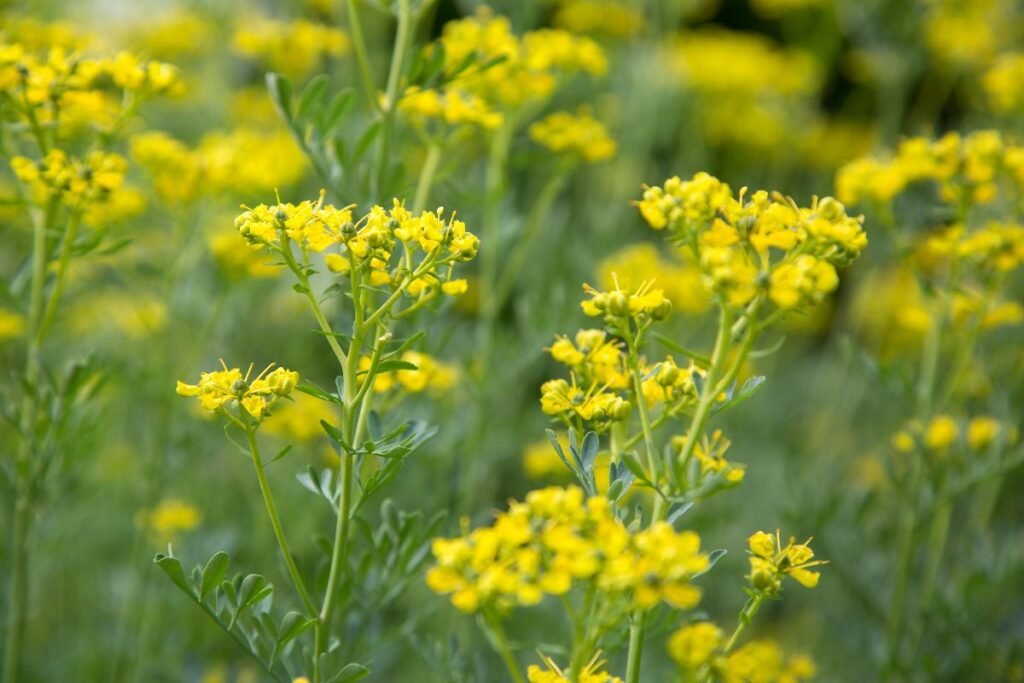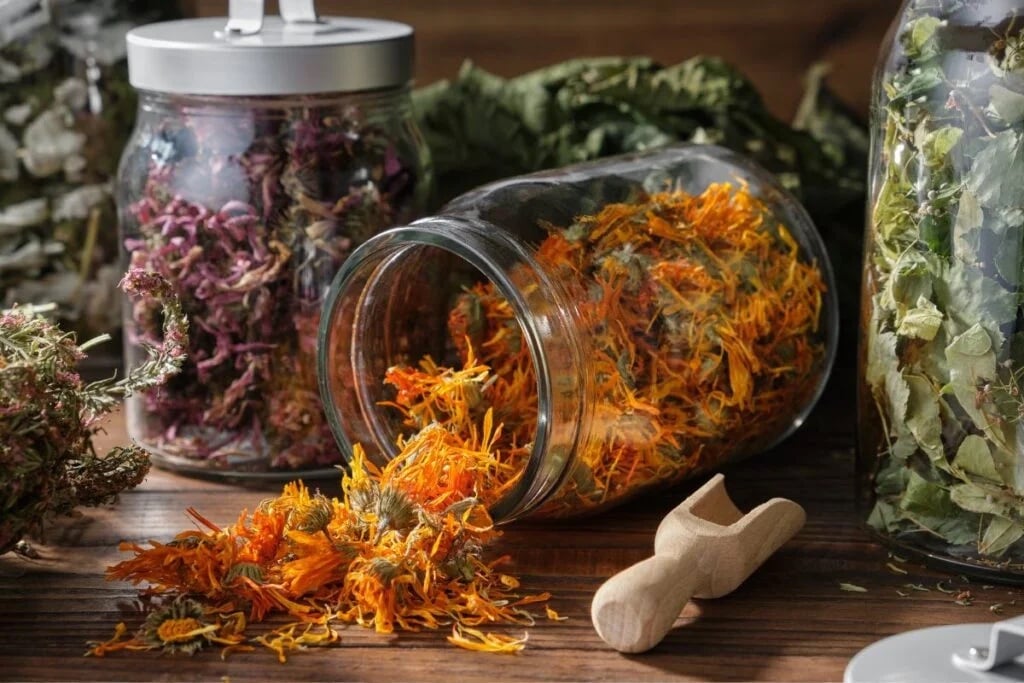Rue tea, or ruda decoction, is often found in some population folklore. Most of the time, our knowledge is limited to the fact that rue tea is used to terminate unwanted pregnancies. Rue another name is the herb-of-grace for a reason. Rue tea benefits are abundant. On the other hand, you should know how to prepare and consume it properly.
Rue: Appearance, Distribution, and Uses
Ruta belongs to the genus Rutaceae. There are a total of 14 different species at this moment. Ruta is native to the Balkans. It is now widely distributed in the Mediterranean region and Southeast Asia. It is a perennial herb or shrub, 20–80 cm tall. The most distinctive feature of rue is its strong, pungent smell. The whole plant and the flowers smell strongly. The plant stem branches heavily, and the lower part is woody. The leaves are bluish-green, dark green in some species, compound, 2-3 times pinnate, with ovate or lanceolate leaflets. The flowers of Ruta are yellow or yellowish. The flowers are bisexual, clustered in umbellate clusters at the top of the shoots. The fruit is a capsule.
Ruta graveolens is a medicinal and herbaceous plant. The perfumery industry uses rue essential oils. The herb common rue is a source of rue tea. However, you should note that all types of rue are poisonous plants. Handle the raw material with care. Consult a doctor or pharmacist before using rue tea.
Warning! Under no circumstances should pregnant or lactating women, children, and seniors consume rue tea.
Rue in Mythology and Folklore
Folklore highly value the healing properties of Ruta. So it is not surprising that myths and legends about this plant abound. Because of its bitter taste, rue is a symbol of regret, repentance, and sadness. It is frequently the herb of grace and a symbol of forgiveness.
Rue was such a powerful herb that even Basilisk, the mythical serpent king, was afraid of it. In the Middle Ages, rue was incensed to ward off the devil, witches, and other evil spirits. People believed rue in curing many diseases. The priest used to throw rose petals into the holy water in the Catholic Church of at the beginning of St. Mass.
Rue is the national flower of some cultures. You can find it in folk art, such as ornaments and decorations. Folklore people wrote songs, stories, rhymes, and fairy tales about it. Ruta is a symbol of virginity and purity.

Rue Tea Benefits to Improve Health
Since ancient times, people used rue tea to stimulate menstruation, reduce blood pressure, and even treat some mental illnesses. However, due to its toxicity, the popularity of rue tea has slowly faded. On the other hand, rue tea can relieve many ailments if the prescribed dosage, preparation, and consumption recommendations are followed. Ruda tea:
- Stimulates urine excretion and is therefore suitable for those with urinary tract infections, kidney stones, or urinary tract stones. It also has anti-inflammatory properties and can help cure urinary tract infections.
- Improves bile excretion, stimulates the appetite, and ensures digestive function.
- It can stimulate menstruation, normalize the menstrual cycle, and reduce pain during this period. Rue tea has been used to terminate pregnancies in the past. This is extremely risky for the life of both the baby and the mother. Many women have died after bleeding to death.
- Dilates blood vessels and is an effective remedy for relieving headaches, especially in the eye area.
- It has a calming and antispasmodic effect and has been used to relieve symptoms of hysteria and even epilepsy.
- Lowers and normalizes blood pressure. Therefore, people taking blood pressure-lowering drugs should be cautious when using rue tea.
- It helps with chronic venous insufficiency and reduces leg swelling.
- Reduces inflammation and may relieve joint pain caused by gout or arthritis.
- Reduces fever and relieves expectoration. Effective in relieving breathing in cases of cold or upper respiratory tract diseases.
- It is antibacterial, so it helps fight infections of the colon, urinary tract, or intestines. It is even effective in treating salmonellosis and food poisoning.
External Use of Rue Tea
Rue essential oil is the most suitable for external use, but rue tea can be equally effective. You need to prepare a stronger concentration of rue tea for this purpose. Just make sure you are not allergic to rue beforehand. Try rubbing a small area of the skin. However, even if you are not allergic, protect the area from sunlight. When exposed to the sun, the active ingredients in rue cause skin damage, irritation, rashes, etc.
Externally, rue tea is as a compress:
- For eczema and other skin conditions. Rue tea compresses soothe and heal itchy, red, and damaged skin.
- As it has anti-inflammatory and antibacterial properties, it can treat wounds. It is particularly suitable for treating open, bleeding wounds, ulcers, and bedsores.
- It is also effective for bruises, joint pain, and even hernia or rheumatism pain.
- Rinsing your hair with a decoction of rue tea will make it shinier, healthier, and stronger. Rinsing soothes an irritated scalp and has an anti-inflammatory effect. It is also suitable for scalp diseases.
- Rinsing with rue tea for hair infected with lice. It helps to recover from them, and the smell will repel these parasites and protect against re-infection.
- You can steam ruda tea to purify the air in the room, protect against viruses and bacteria, and improve respiratory function.

Side Effects of Rue Tea
As mentioned at the beginning, rue is a poisonous medicinal plant. Therefore, people should consume ruda tea responsibly and only for medicinal purposes. It is essential not to exceed the recommended dosage of the tea. Also, do not brew tea from fresh rue. Use only dried plants.
The toxic effects of rue tea can be manifested in a variety of ways, including:
- May cause drowsiness, cramps, or dizziness.
- May cause miscarriage, fetal death, or malformations in pregnant women. It is prohibited!
- It is contraindicated for breastfeeding women because it may impair the development of the baby. In milder cases, it causes lactation disorders and milk reduction.
- Do not use it during heavy menstrual periods. It may cause more bleeding.
- Unsafe for children and seniors.
- It may cause dangerous poisoning: stomach pain, vomiting, and nausea.
- May cause kidney damage.
- In more extreme cases, poisoning can lead to respiratory failure and even death.
- May cause allergic reactions.
Preparing Raw Materials for Rue Tea
Fresh ruda is too toxic, so use only dried raw material for tea. Harvest the whole above-ground part of the plant for drying. Cut off as soon as it starts to flower, leaving only the stems, which are 10–15 cm high. Do not cut out in the first year of growth. You can harvest the raw material can only in the second year of growth. Dry the herb-of-grace in a cool, well-ventilated room, protected from direct sunlight. When properly dried, the raw material is light green and has a specific smell and a spicy, bitter taste.
Shred the dried-out rosettes and discard the coarsest stems. Store it in tied cloth (ideally linen) or paper bags. Keep them in a dark, cool, and well-ventilated place. If stored correctly, they are suitable for up to 2 years.
Preparation and Use of Rue Tea
When preparing rue tea, the quantities indicated must be strictly observed. Also, do not exceed the recommended amount to be consumed.
Ingredients:
- 1 tbsp. of dried rue leaves
- 1 glass of water
Preparation. Pour a glass of boiling water over the rose petals, cover, and leave to stand for 10-15 minutes to soak. Drain and drink.
It is advisable not to drink it in one sitting. Sip it slowly throughout the day. Do not to drink more than 250 ml of tea per day. Continue treatment for up to one week.

Rue Tea for Painful and Irregular Periods
This tea can help to regulate the menstrual cycle and relieve the pain and cramps caused by menstruation. It is not suitable for women who suffer from heavy menstruation, as it can cause heavy bleeding.
Ingredients:
- 2 tbsp. of dried rue
- 2 glasses of water
Preparation:
Pour boiling water over the rue leaves, cover, leave to infuse for 10–15 minutes, and drain.
The tea is taken on the first day of menstruation and should be drunk for five consecutive days. After that, use is discontinued. It is recommended to take 1 tablespoon three times daily. If necessary, you can repeat the treatment during the next cycle.
Ruta Tea to Relieve The Symptoms of Climacteric
Rue tea benefits alleviate the symptoms of severe and troublesome climacteric. However, be sure to consult your doctor before use. Ruda tea is a medicine, not a supplement, and should be used with great care and responsibility.
Ingredients:
- 1 tbsp. of dried rue leaves
- 2 glasses of cold, boiled water
Preparation:
Pour cold boiled water over the rue leaves, cover, and leave to steep for 8 hours. Drain.
Use: Drink 0.5 glasses before meals four times a day. Use for up to 1 month. Take a 7-day break. If necessary, continue treatment for another month.
Ruda tea is a medicinal preparation. Therefore, all advice is informative. You should consult your doctor or pharmacist for the specific method and quantity of use. Do not self-medicate, as herb-of-grace can be a deadly poisonous plant.
Sources:
https://www.vle.lt/straipsnis/ruta/
https://www.webmd.com/vitamins/ai/ingredientmono-885/rue
https://www.stylecraze.com/articles/benefits-of-rue-herb-for-skin-hair-and-health/
https://www.utep.edu/herbal-safety
Associative photos from © Canva.

